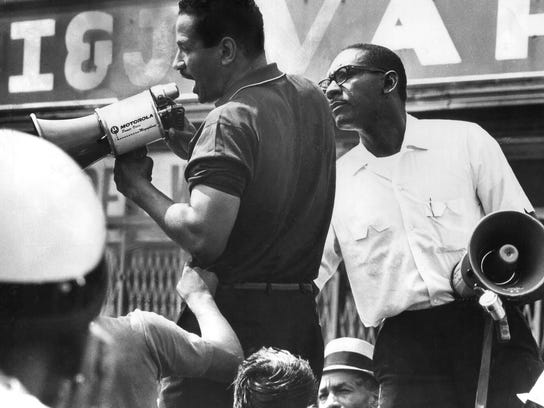The sound of a ringing phone was heard inside the Dexter Avenue home of U.S. Rep. John Conyers Jr. around 9 a.m. on July 23, 1967.
The Detroit Democrat’s field representative, Arthur Featherstone, took the call. Conyers, then 38, was needed at the corner of 12th and Clairmount, where a crowd of hundreds had gathered.
“There was an ugly crowd there and would the congressman be kind enough to come?” asked Detroit Deputy Police Chief Hubert Locke to Featherstone.
It was the start of a fateful day for Conyers, who at the time was serving his second term in Congress. And while it’s been 50 years since that summer, Conyers, now 88, says there are some things one can never forget.
The angry faces of the men looking back at him as he stood atop a car on 12th. The rumble of military tanks rolling down the street outside his home on Dexter. The site of police riding around the city in Ford police cruisers in pairs of four.
“And I will never forget the sound of tanks going down Dexter Avenue, which is not that wide of a street to begin with. The sound of the tanks just ... it was exacerbated. The streets were so narrow that the sound kept coming. It looked like it was a military invasion,” said Conyers, the longest-serving current member of the House of Representatives, from his office inside Detroit’s federal courthouse last month.
Seeing the mayhem and destruction around him on 12th, Conyers — with the help of Featherstone and others — climbed atop a parked car, megaphone in hand, shirt-sleeves rolled above his elbows, and faced the rage head on.
‘They listened to him’
Conyers said he was attempting to quell the looting and violence that had erupted.
“I was trying — as a supporter of Dr. (Martin Luther) King and one who worked on nonviolence and community order — I was trying to discourage that,” he said.
It was a critical moment in the 1967 riots captured by photographers: Conyers standing on top of a car surrounded on all sides by a crowd. Images of the congressman talking to a group of mostly black men were published in newspapers in Detroit and around the nation.
Many of the men looked like Conyers, dressed in button-up shirts. Many donned fedoras and other hats of the time, such as a trilby or newsboy. They appeared to be working-class, blue-collar people gathered on the street.
None appeared armed. For a moment, most stood with hands on hips and their heads up, looking at Conyers and listening.
Voting is beautiful, be beautiful ~ vote.©


No comments:
Post a Comment